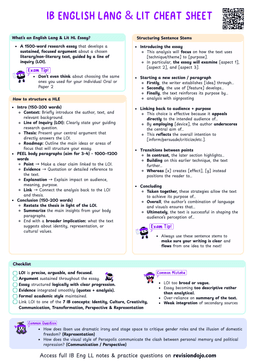The Commentary: Marking Rubric
- In both SL and HL, students can earn up to 20 points per essay. However, HL students write two essays, making their total score out of 40 points.
- The essays are evaluated based on the following criteria:
Why This is a 20/20 Model Answer
This essay achieves full marks by excelling in all four IB Paper 1 marking criteria:
- Criterion A: Understanding and Interpretation (5/5): The response thoroughly explores the text’s purpose, audience, and message.
- Criterion B: Analysis and Evaluation (5/5): It effectively analyzes literary, rhetorical, and visual techniques and evaluates their impact.
- Criterion C: Focus and Organization (5/5): The argument is well-structured, logically sequenced, and cohesive.
- Criterion D: Language (5/5): The writing is precise, academic, and clearly communicates ideas.
Criterion A: Understanding and Interpretation (5 points)
- Your ability to understand and interpret the text in depth.
- Whether you recognize themes, audience, purpose, structure, and stylistic features.
- How well you support your points with textual evidence.
How to get full marks (5/5):
- Identify the text type, purpose, and target audience
- Include a clear thesis statement summarizing how the text achieves its purpose
- Demonstrate an excellent understanding of themes, structure, font, images, and stylistic devices
- Provide insightful and well-developed analysis that goes beyond surface-level interpretation
- Use textual evidence naturally, embedding quotations seamlessly in your argument.
Criterion B: Analysis and Evaluation (5 points)
- Your ability to analyze and evaluate the text’s techniques.
- How well you break down the text’s structure, style, and literary devices.
- Your understanding of how these elements contribute to the text’s purpose.
How to get full marks (5/5):
- Identify and evaluate key literary devices (imagery, metaphor, juxtaposition, tone, etc.)
- Explain how these features contribute to the text’s meaning and effect
- Discuss the text’s structure, font, layout, and colors (if applicable)
- Connect all analysis to the text’s purpose and audience.
Criterion C: Focus and Organization (5 points)
- The clarity and logical structure of your essay.
- How well you develop and maintain a coherent argument.
How to get full marks (5/5):
- Clear introduction with text type, audience, purpose, and a strong thesis statement
- Logical paragraph structure with topic sentences and smooth transitions
- Each paragraph focuses on a specific theme or technique
- Well-structured argument with no unnecessary repetition
- Strong conclusion that summarizes key points and restates the thesis.
Criterion D: Language (5 points)
- The clarity, precision, and sophistication of your writing.
- Your ability to use an academic and formal register.
How to get full marks (5/5):
- Use precise and sophisticated language with a wide vocabulary
- Maintain a formal, academic tone throughout the essay
- Avoid grammatical errors and awkward phrasing
- Use varied sentence structures to keep writing engaging
- Ensure smooth flow and coherence in writing.
4. Key Strategies for High Marks
- Practice with Past Papers: The more unseen texts you analyze, the better!
- Memorize Key Terminology: Be precise with literary and linguistic terms
- Time Yourself: Simulate exam conditions when practicing
- Develop a Strong Personal Voice: Avoid summarizing, instead, offer insightful analysis
- Use Connectives: Make your essay flow (e.g., Furthermore, Conversely, This reinforces…)
- Review Mark Schemes: Understand IB’s assessment criteria.
- Mastering Paper 1 requires a balance of critical thinking, structured writing, and time management.
- The key is to analyze, not summarize, and to provide clear evidence for your arguments.
- With enough practice, you'll develop the confidence and skills to excel!
Criterion A: Understanding and Interpretation (5/5)
- Clear Identification of Purpose:
- The introduction successfully distinguishes between primary (brand awareness and profit) and secondary (workplace empowerment) purposes.
- The conclusion reinforces the purpose by stating how Dettol’s strategies align with its commercial aims during the pandemic.
- Sophisticated Audience Analysis:
- The response recognizes that Dettol’s campaign targets lower to middle-class Britons by using colloquial language and workplace empowerment themes.
- It links audience engagement to cultural familiarity (e.g., "sticky tube floors" as a shared British experience).
- Strong Contextual Awareness:


